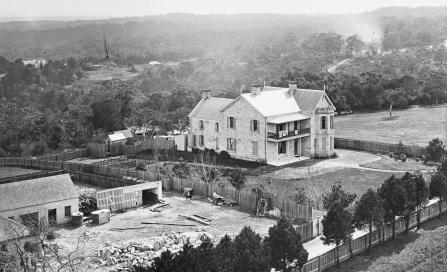|
‘Upton Grange’,22 Edward Street, North SydneyWe do not know who designed ‘Upton Grange’ but Council property registers indicate that a ‘dwelling house’ existed on the site in Edward Street from 1870 or 1871.The house was reportedly built by Francis Lord, land owner and former politician, for his daughter Sarah and her husband Francis Hixson, the President of the Marine Board of New South Wales which managed lighthouses and navigational issues at a time when sea travel still connected the coastal towns of the colony in the absence of road and rail. However, those same registers also indicate that while the Hixsons owned the house from 1871 until after Francis’ death in 1909, others were living in it. All were professional people – evidence of the desirability of the area. By 1881 the prominent ecclesiastical and commercial architect William Wardell was living at 'Upton Grange', having moved from Melbourne in 1878. Wardell had already designed the Gothic Revival Cathedral, St Mary’s, for the Catholic Church in Sydney. He had probably become familiar with, and presumably fond of, the local North Sydney area having designed St Francis Xavier Church and school above Lavender Bay for the Jesuits. Shortly after, Wardell designed school buildings for the local St Marys Catholic School in Ridge Street, North Sydney. With as many as 12 rooms, 'Upton Grange' was a substantial and comfortable home. But it was an ideal house for Wardell, too, for it combined the Gothic style that he was so familiar with and the continental Italianate style that he was coming to embrace. These elements are clear in the photograph taken from the neighbouring mansion 'The Towers' in 1875. The faceted bay front is typical of Italianate design while the battlements, or castellation, at the top of the bay is characteristic of the Gothic. The latter style is also suggested by the high pitched rooflines, the decorative bargeboards that line the gables and the very prominent finials that point upwards from the gable tops. Lastly, the unrendered stonework gives the building a rustic or organic appeal that is another feature of Gothic architecture. In 1875 'Upton Grange' was still a young house. Its sandstone blocks look freshly cut and are mostly unstained. The garden, too, is new with small shrubs lining the paling fence along with a mix of saplings both decorative and productive. When mature, the fruit trees would have added to the self-sufficiency provided by the vegetable garden at the back. Note the rain water tanks. Three near the house would have captured water for domestic, and possibly garden, use in the absence of piped water which was still a decade away. Note also the outdoor stone toilet with its own tank suggesting a lavatory that flushed, albeit probably into a pit as sewers were not installed in North Sydney until the 1890s. At this stage in the area’s urban transformation, 'Upton Grange' is still at the forest’s edge. Shortly after, the trees beyond the back garden were felled to make way for Bank, Euroka and Clifton Streets, all part of the subdivision of the Euroka Estate. These were destined to be filled with small workers’ cottages that would stand in stark contrast to the grand homes like 'Upton Grange', 'Graythwaite' and 'The Towers' on the hill. 'Upton Grange' survives and can be easily seen from Edward Street, North Sydney, though it is now joined to buildings erected by Shore School which owns it.
|
|


